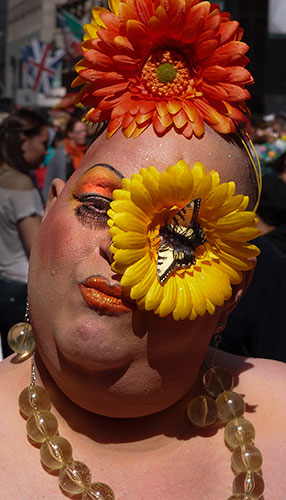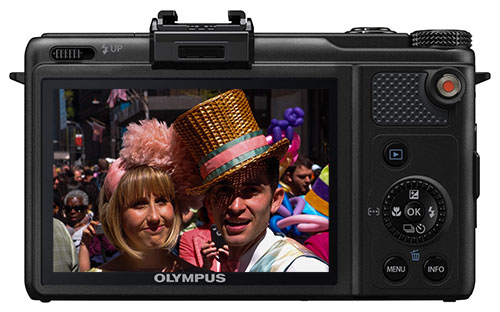Best Pocket Camera:
Shootout of FiveTop Models
Olympus XZ-1

If this Pocket Camera shootout was judged on the contestant's quality of still images, then the Olympus XZ-1 would ascend to #1, especially when taking photos in well-lit conditions.
When shooting the Easter Parade on Fifth Avenue, the images taken with the XZ-1 set my eyelids aflutter because they were so consistently rich and silky.
Alas, there were other factors involved in this shootout and the relatively stocky XZ-1 didn't fare as well on the pocket-ability scale and is the most expensive camera of the group.
The Good, the Bad and the So-so
The Olympus XZ-1 doesn't perform well in low light conditions, particularly when you have to set the ISO over 800. The images begin to exhibit too much distracting noise.
If you are shooting JPEGs, the in-camera image processor tends to apply too much noise reduction, which softens the images. If you opt to capture RAW images, the in-camera noise reduction is turned off and you can dial up your own level of reduction in a program like Photoshop.
Remember, this noise is a problem at high ISO numbers. I would suggest setting the XZ-1 to capture both RAW and JPEG formats. (You can read about that option in the manual.) As a test, shoot under a variety of conditions and compare the two choices. Then to save storage space and battery life, pick the one that best suits your needs.
On the plus side, the lens on the XZ-1 is one of the fastest in the shootout, with 1.8 being the widest aperture. The wider the aperture, the more light comes through the lens allowing you to keep your ISO setting low.
Other features that you may find useful include Macro and Super Macro settings for those close-ups and extreme close-ups of flora and fauna. (Again, read the manual to locate how to choose these functions.)
The multiple Art Filters and the Scene modes found in many new digital cameras often seem gimmicky and the XZ-1 has its share of them. Though you might feel an Art Filter like Grainy Film or Dramatic Tone strikes your fancy. Or a Scene selection like Cuisine might be a perfect quick setting for capturing that assortment of peppers at the Farmers Market.
A couple of other points, the Olympus designers do not provide a grip on the front of the camera and only a slight grooved surface on the back for your thumb, which doesn't give you the most secure feeling when holding the XZ-1. For a little tighter rein, you could wrap the strap around your right thumb.

The three inch display on the back is fine if you aren't shooting in bright sunlight and then it becomes almost useless. Olympus does offer the VF-2, an electronic viewfinder that attaches to the XZ-1's hotshoe. It's a great accessory. Only problem, at $249, it costs half as much as the camera itself.
Also, unless you are a savant, be prepared to consult the manual. The basic operation of the XZ-1 is fairly simple. But with a camera with this many options, the location of some of the functions, (like where you choose between the RAW or JPEG format) are not instantly apparent.
Finally, the XZ-1 records HD video in 720p resolution and not 1080. If you are only posting videos on the Internet, 720 is perfectly fine. If you have dreams of being a low budget David Fincher, then opt for a camera that shoots at 1080p.
Conclusion
Of the five cameras in this Pocket shootout, buy this Olympus XZ-1 if your primary concern is the quality of still images (not video) and you are willing to tradeoff true pocket-ability for PQ (picture quality).
The XZ-1 is the most expensive camera in the group, but as its product cycle nears its demise, you might be able to grab one at an irresistible price.





















